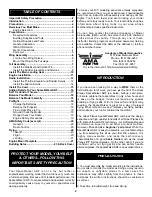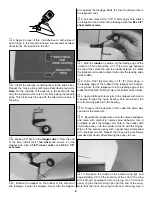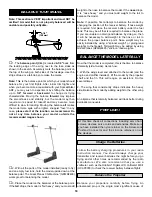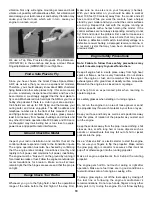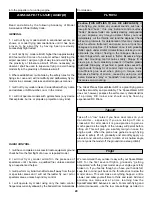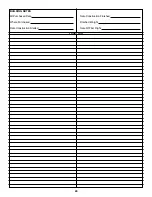
❏
2. Apply 6 drops of thin CA adhesive to both sides of
each hinge in the elevator. Allow a few seconds between
drops for the CA to wick into the slot.
❏
3. Install the ailerons, centering them in the aileron bay.
Repeat the hinge gluing technique described previously.
Note:
On the red side of the aileron, in the second rib bay
from the inward end, there is a horn block along the leading
edge. This block must line up with the aileron servo hole in
the wing.
❏
4. Make a 90° bend in the
tailgear wire
1" from the end
of the wire. Install the
1" tail wheel
and secure it to the
tailgear wire with a
3/32" wheel collar
and
2-56 x 1/8"
set screw.
❏
5. Position the tailgear on the bottom of the aft end of
the fuselage. Center the tailgear mount with the tailgear
wire against the fuselage. Mark the four mounting holes in
the tailgear mount.
❏
6. At each mark drill a 1/16" [1.6mm] pilot hole. Attach
the tailgear to the bottom of the fuselage with four
#2 x 3/8"
sheet metal screws.
❏
7. Hold the
rudder
in position on the trailing edge of the
vertical fin. There should be a 1/16" [1.6mm] gap between
the top of the vertical fin and the rudder balance tab. Mark
the tailgear arm location where it will enter the leading edge
of the rudder.
❏
8. Drill a 3/32" [2.4mm] hole, 1-1/4" [31.7mm] deep, in
the leading edge of the rudder at the tailgear arm location.
Cut a groove for the tailgear wire in the leading edge of the
rudder from the 3/32" [2.4mm] hole to the bottom of the rudder.
❏
9. Apply a little petroleum jelly to the tailgear wire where
it passes through the nylon bearing. This will prevent the
wire from being glued into the bearing.
❏
10. Prepare the hinge slots in the rudder the same way
you did for the elevators.
❏
11. Roughen the tailgear wire arm with coarse sandpaper
and clean with alcohol to improve glue adhesion. Use a
toothpick to pack the tailgear arm hole in the rudder with
30-minute epoxy. Join the rudder to the fin with the hinges.
Wipe off the excess epoxy with a paper towel dampened
with isopropyl alcohol. Repeat the hinge gluing technique
described previously after allowing the epoxy to cure.
❏
12. Roughen the inside of the plastic wing tips and
approximately 1/8" of the covering at the end of the wing
with 400-grit sandpaper before gluing. Use 30-minute
epoxy to glue the two wing tips onto the end of the wing.
Note that the lip on the wing tip fits over the wing. Use a
9


